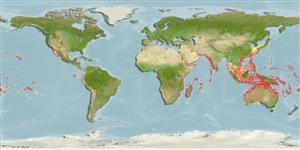Common names from other countries
Environment: milieu / climate zone / depth range / distribution range
Ecología
Asociado a arrecife; salobre; rango de profundidad 0 - 95 m (Ref. 96667). Tropical
Distribución
Países | Áreas FAO | Ecosistemas | Ocurrencias, apariciones | Introducciones
Indo-Pacific: Red Sea to Cocos Islands.
Length at first maturity / Tamaño / Peso / Age
Maturity: Lm ? range ? - ? cm Max length : 2.0 cm CL macho / no sexado; (Ref. 107481); 2.325 cm CL (female)
It is found on pneumatophores and roots of Avicennia marina (Ref. 107904). Active during low tide, but many are observed at high tide moving to mangrove roots above water level. Also lives among roots of Rhizophora mucronata. Feeds on mainly on macroalgae, a bit of mangrove leaves and mud; animal items were rare but may be an opportunistic feeder to a certain degree (Ref. 108401).
Life cycle and mating behavior
Madurez | Reproducción | Puesta | Huevos | Fecundidad | Larva
Members of the order Decapoda are mostly gonochoric. Mating behavior: Precopulatory courtship ritual is common (through olfactory and tactile cues); usually indirect sperm transfer.
MarineSpecies.org. 2050. (Ref. 3477)
IUCN Red List Status (Ref. 130435)
CITES status (Ref. 108899)
Not Evaluated
Not Evaluated
Human uses
| FishSource |
Herramientas
Más información
Age/Size
Crecimiento
Length-weight
Length-length
Morfología
Larva
Abundancia
Fuentes de Internet
Estimates based on models
Preferred temperature
(Ref.
115969): 24.3 - 29, mean 27.7 (based on 1472 cells).
Price category
Unknown.
